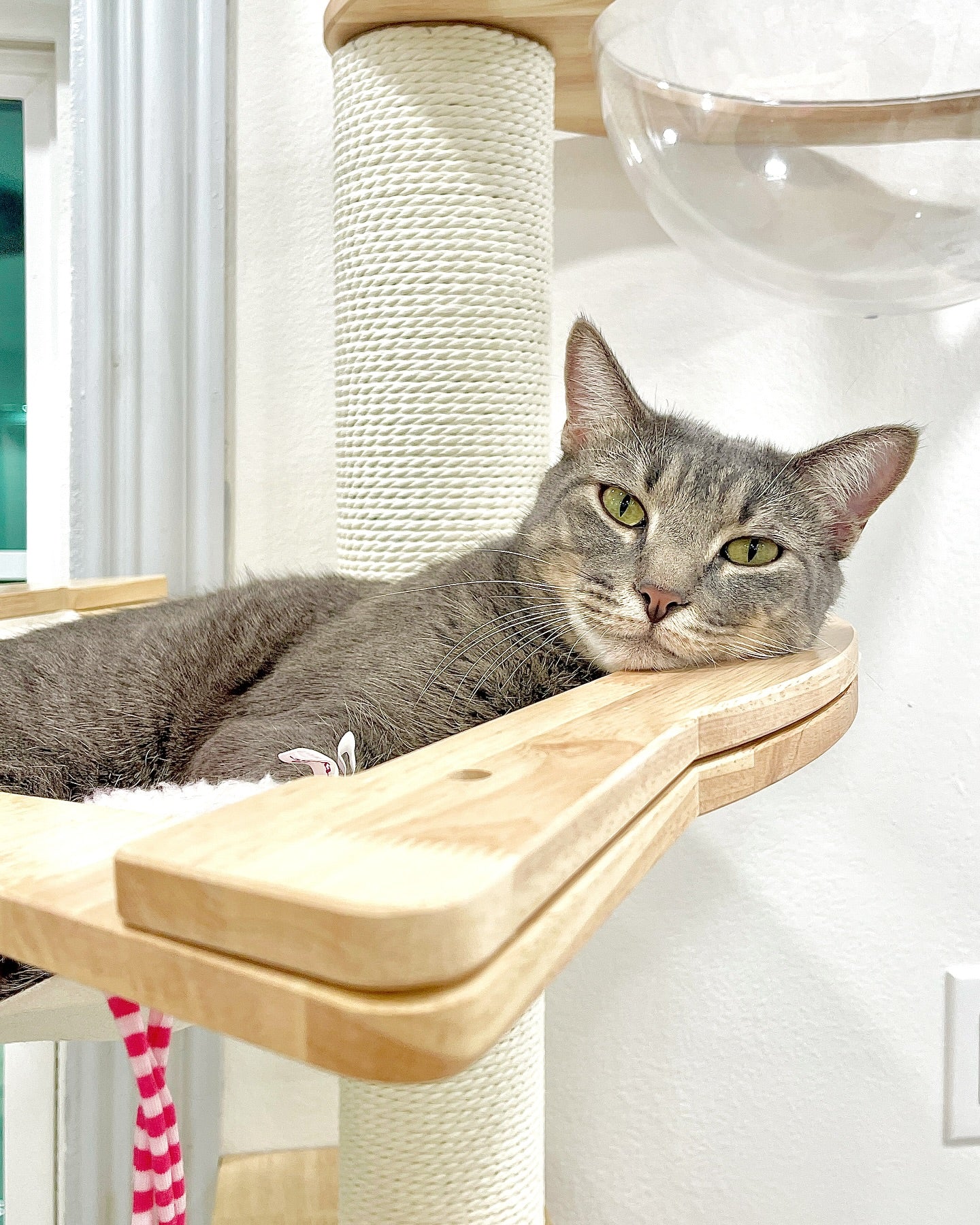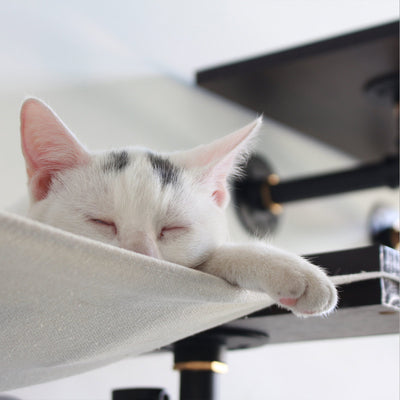Toys play an incredibly important role in stimulating your cat, helping to maintain their behavior and well being, as well as providing exercise. They’re particularly crucial for indoor cats, who may not enjoy as much stimulation as their outdoor counterparts. With hundreds of options available, it can be tricky to figure out what toys are best for your cat. Check out our tips below to keep your feline friend entertained and safe.

Why Do Cats Need Toys?
Just like humans, cats need both physical and mental exercise to stay fit, healthy and happy. Getting sufficient physical stimulation and mental enrichment helps to enforce your cat’s good habits, and means they will be less prone to behavioral issues. When cats don’t get enough exercise, they can turn to disruptive actions like hyperactivity at night, scratching at unwanted surfaces, or play aggression.
Playing also solidifies the human-animal bond. Whenever you play with your cat, you are building trust and affection, plus toys will help to keep them entertained when you can’t be there.
What Toys are Best for My Cat?
The type of toys that suit your cat best will depend greatly on their temperament and habits. Most cat toys seek to engage their natural instincts: chasing, pouncing, scratching, and climbing. Your cat may enjoy indulging in one of these behaviors more than the others; or they may prefer a variety of types.
We recommend not purchasing too many toys until you’ve learned your cat’s preferences and habits, to avoid wasting money on toys that will collect dust.
Types of Cat Toys to Consider
-
Balls: Some cats love chasing balls and batting them. You could try a regular ball, one with a bell inside (a ‘jingle ball’), a motorized ball or even a crumpled paper ball.
-
Toy mice, and other hunting toys: Cats are natural predators and toys that tap into their prey drive can keep them entertained for hours.
-
Wands/fishing pole/feather teaser toys: Toys like Feather Teaser or the Motion Electronic Toy will encourage leaping, pouncing, and stalking. Just ensure that any toys that include string are only used under your supervision, and are safely stored away from your cat after playtime, to avoid accidental ingestion.
-
Laser pointer: You’ve probably seen plenty of YouTube videos with cats going crazy for laser pointers! They can be relatively inexpensive and effort-free way to give your cat a good workout. Just ensure you get one that’s safe for animals.
-
Interactive feeding toys: Food puzzle toys stimulate your cat’s mind and can help entertain them when you’re not around; the Indoor Hunting Feeder by Doc and Phoebe is a great option.
-
Climbing toys: Cat trees and perches give your cat something to climb when you’re not home, as well as places to nap. Cats love having high surfaces to perch on.
-
Scratching posts: Cats love to scratch; it’s a natural instinct that helps them stretch, exercise back and shoulder muscles, and express happiness. It also helps to keep their nails trimmed somewhat. Specific scratching posts encourage your cat to scratch where you want them to – and save your couch from being shredded! We recommend at least one scratching post per cat to avoid territory issues. While vertical scratching posts are most common, some cats prefer horizontal surfaces for scratching, such as a jute door mat or corrugated cardboard scratcher.
-
Catnip toys: Some cats adore catnip (although it’s worth noting that most cats don’t develop a sensitivity until four to six months, so for very young kittens, it’s best to hold off). It’s fairly easy to find toys infused with catnip, such as catnip-infused mice.
-
Household items, like cardboard boxes: Cats enjoy using cardboard boxes and other hiding places to play in; they love having enclosed, dark places to hide and observe the world. When inside a box, they feel protected because they are in an enclosed space. Cats are also curious creatures and are naturally drawn to the texture of cardboard to scratch, and to dark places to explore. Cutting holes in a cardboard box will often offer hours of entertainment for a cat, as they can hide whilst observing their environment (practicing their natural stalking tendencies). By hiding treats or toys inside a box for your cat to retrieve, you can also tap into their predatory instincts. You can also link up several boxes of different sizes to create an obstacle course or maze for your cat. These are one of the easiest toys to find – just repurpose a shipping box! Make sure there are no staples in the cardboard that could hurt your cat, and remove any tape so they do not chew on or swallow it.
The best cat toys seek to engage their natural instincts: chasing, pouncing, scratching, and climbing.
Cat Toys You Should Avoid
Keep in mind that not all toys are safe for cats. Contrary to popular depictions, they shouldn’t be playing with balls of yarn or string. If swallowed, yarn, string, ribbons, or similar materials can get stuck in your cat’s gastrointestinal tract, causing serious damage that can be fatal for your cat if left untreated.
Plastic can also cause intestinal damage, so keep plastic bags out of reach and monitor the toys that your cat plays with and chews on. If your cat starts destroying a soft toy with strings or other hazardous materials, throw it out immediately.
How to Play With Your Cat
To interest your cat in play, assemble several toys and your cat in an environment where they can focus on you. Twitch the toy in front of them, just out of reach. You will know you’ve succeeded when they pounce, bat at, or try to chase the toy. You might also throw some toys around, or roll a ball past them.
It could take time to find the balance between letting your cat catch the toy and keeping it out of their reach to maintain their interest. Take note of what works as you go, and don’t be afraid to try new motions or techniques!
How NOT to Play With Your Cat
Some types of play are less desirable. For instance, play-fighting with littermates is a natural part of a kitten’s socialization process, but without a littermate to play with, most kittens will turn toward their human companions.
We know kitten play-fighting can be adorable, but play-fighting with your kitten or cat can result in biting and scratching, and it can be hard for you to break this habit later. (Which means guests in your home could also inadvertently become targets for play-fighting—something you probably want to avoid!)
Discourage play-fighting by refusing to engage or acknowledge it and instead redirecting the play desire to something appropriate like a toy. Keeping your kitten’s nails trimmed will also reduce the damage they can do to unprotected skin.
Remove Damaged Toys ASAP
As soon as you notice any sort of damage on your cat’s toys, such as a ripped toy or a piece breaking off, you should take the toy away from your cat and dispose of it. Any size piece can pose a choking hazard, while sharp elements and bits of rope or ribbon can be particularly dangerous when it comes to intestinal punctures or blockages.
Speak to Your Vet for Further Advice
If you can’t seem to find the right toy for your cat, or you’re concerned about the safety of any of their toys, speak to your vet for advice. They can provide further recommendations for how to keep your cat stimulated in a safe, healthy way.



